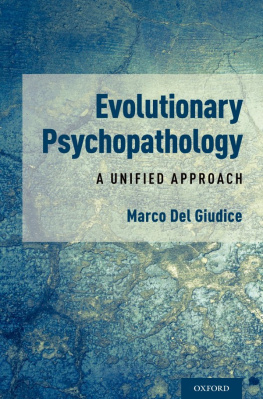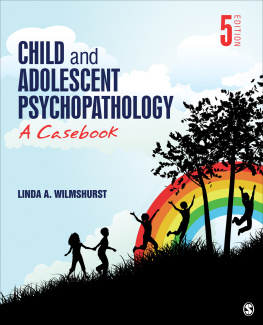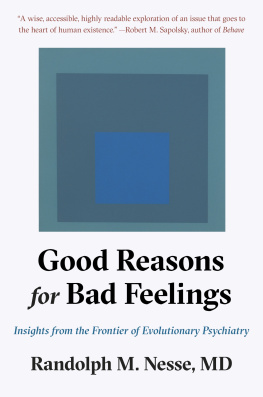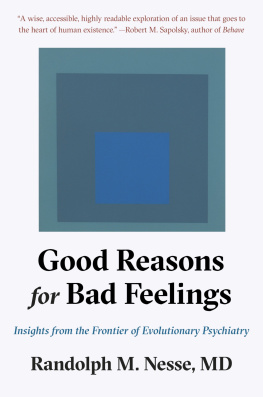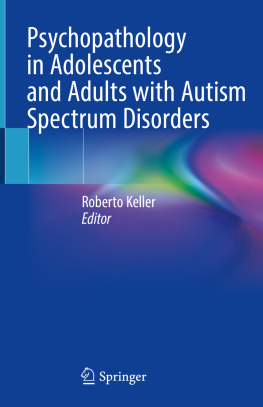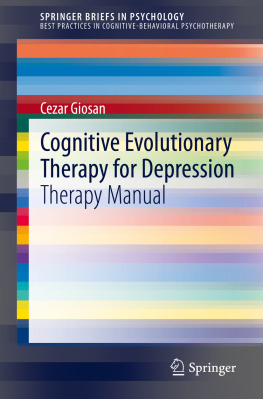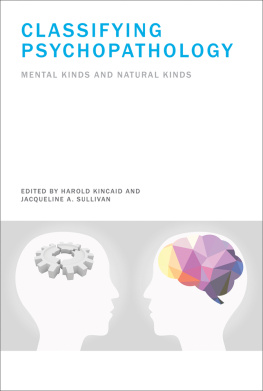Evolutionary Psychopathology

Oxford University Press is a department of the University of Oxford. It furthers the Universitys objective of excellence in research, scholarship, and education by publishing worldwide. Oxford is a registered trade mark of Oxford University Press in the UK and certain other countries.
Published in the United States of America by Oxford University Press
198 Madison Avenue, New York, NY 10016, United States of America.
Oxford University Press 2018
All rights reserved. No part of this publication may be reproduced, stored in a retrieval system, or transmitted, in any form or by any means, without the prior permission in writing of Oxford University Press, or as expressly permitted by law, by license, or under terms agreed with the appropriate reproduction rights organization. Inquiries concerning reproduction outside the scope of the above should be sent to the Rights Department, Oxford University Press, at the address above.
You must not circulate this work in any other form and you must impose this same condition on any acquirer.
Library of Congress Cataloging-in-Publication Data
Names: Del Giudice, Marco, author.
Title: Evolutionary psychopathology : a unified approach / Marco Del Giudice.
Description: New York, NY : Oxford University Press, [2018]
Identifiers: LCCN 2018008306 | ISBN 9780190246846 (hardback) | ISBN 9780190670146 (epub)
Subjects: LCSH: Psychology, Pathological. | BISAC: PSYCHOLOGY / Clinical Psychology. | PSYCHOLOGY / Developmental / General.
Classification: LCC RC454.4 .D45 2018 | DDC 616.89dc23 LC record available at https://lccn.loc.gov/2018008306
Per Alice,
il nostro viaggio pi dolce
Contents
As I was working on this book I was lucky to be able to discuss evolution, psychopathology, and everything in between with many exceptional people around the world. Some of them kindly provided feedback on earlier chapter drafts. My warmest thanks to Riadh Abed, Paul Andrews, Jay Belsky, Brian Boutwell, Martin Brne, Lee Copping, Bernie Crespi, Colin DeYoung, Bruce Ellis, Dan Fessler, Willem Frankenhuis, Steve Gangestad, Marco Garzitto, Paul Gilbert, Phil Kavanagh, Leif Kennair, Dario Maestripieri, Michelle Martel, Geoffrey Miller, Lars Penke, George Richardson, William Skiba, Alfonso Troisi, Paul Watson, and Ron Yeo.
This is the present: looking back, my gratitude goes to the years at the Center for Cognitive Science in Turin, where Bruno Bara and Livia Colle gave me the time, space, and intellectual freedom to find my own path (it took a while). I also want to acknowledge a special debt to Giovanni Liotti, whose work had a tremendous impact on me as an undergraduate and made me realize the power of evolutionary ideas in clinical psychology. In retrospect, it was his pioneering book with Vittorio Guidano (Guidano & Liotti, 1983) that set me on the quest for an integrated theory of psychopathology.
I have seen many book authors thank their spouses for love, help, patience, and support; now is my turn, and I cant find words good enough to say how incredibly grateful I am. Writing a book is like running a marathon, and my wife Romina ran with me all the way. Finally, Sarah Harrington at Oxford University Press provided invaluable advice and turned the editorial process into a smooth, enjoyable experience.
After decades of pioneering efforts and hard-fought intellectual battles, evolutionary ideas are finally starting to permeate the behavioral sciences. Psychologists and psychiatrists have always recognized that humans are biological organisms and that our thinking, feeling brain is a product of evolution just like the rest of our body. It took much longer to start using the tools of evolutionary biology to explain human behavior and the neural and mental processes that control it. While the integration with biology is still at an early stage, there is little doubt that the influence of evolutionary ideas in psychology is growing rapidly (Buss, 2015). As in other disciplines, the Darwinian insight of natural selection transforms the intellectual landscape, eating through the concepts it touches and changing them in fundamental ways like a universal acid (Dennett, 1995).
The theory of evolution is not only a necessary foundation for the study of normal behavior, but also a powerful tool to understand mental disorders and the (often blurry) interface between normality and psychopathology. Using evolutionary concepts to explain vulnerability to disease is the goal of evolutionary medicine, another long-awaited scientific movement that is now reaching critical mass (Gluckman et al., 2016; Nesse, 2011; Stearns & Medzhitov, 2016; Stearns et al., 2010). The convergence of evolutionary approaches in psychology and medicine should make psychopathology an ideal arena for integration and discovery. And, indeed, interest in the discipline is highthe past 10 years have seen the publication of new and influential models (e.g., Crespi & Badcock, 2008), a major textbook (Brne, 2015), and many empirical studies guided by evolutionary hypotheses. At the same time, it is clear that evolutionary psychopathology has yet to realize its true potential. Its main limitation probably lies in its fragmentationnot just healthy theoretical pluralism, but lack of an overarching framework that would help researchers draw connections between individual models of particular conditions and systematically explore their relations.
The loose conceptual structure of the discipline might explain why, despite the limitations of existing taxonomies such as the one embodied in the Diagnostic and Statistical Manual of Mental Disorders (DSM; American Psychiatric Association, 2013), evolutionary psychopathology has not yet produced an alternative set of classification principles rooted in biological concepts. Seminal attempts in this direction (McGuire & Troisi, 1998; Stevens & Price, 2000) have failed to gather a broad consensus and have not been followed up in the research literature. In the meantime, other approaches have been gaining ground: most notably, structural models of psychopathology based on empirical comorbidity patterns have yielded some important results and are rapidly becoming mainstream (e.g., Caspi et al., 2014; Kotov et al., 2017). Evolutionary scholars have been watching this game from the sidelines, even though their approach is uniquely suited to identify the functional mechanisms that underlie correlations between symptoms and disorders. A related limitation of our discipline is its lack of integration with models of normal individual differences in personality and cognition (Kennair, 2011). Moreover, the developmental dimension of mental disorders has often been neglecteda limitation shared with large sectors of mainstream psychiatry and evolutionary psychology (Del Giudice & Ellis, 2016). In sum, the evolutionary study of mental disorders is advancing locallywith new models and empirical studies of specific conditionsbut lagging behind at the more global level of theoretical integration and classification.
With this book, I aim to make a bold move toward a truly unified approach to evolutionary psychopathology. The conceptual basis for the integrative framework I am advancing is life history theory, a branch of evolutionary biology that deals with fitness tradeoffs and allocations across the life span, with far-reaching implications for the structure and organization of individual differences (Del Giudice, 2014a, 2014b; Del Giudice et al., 2015). The goal is not to replace existing models of particular mental disorders, although the framework does suggest a number of revisions and extensions to current ideas. Instead, a life history framework offers the means to understand patterns of comorbidity between disorders from a functional perspective, link them to meaningful clusters of risk and protective factors, and make sense of the data on sex differences, age of onset, and other important epidemiological features. Building on this foundation, I describe and detail the

